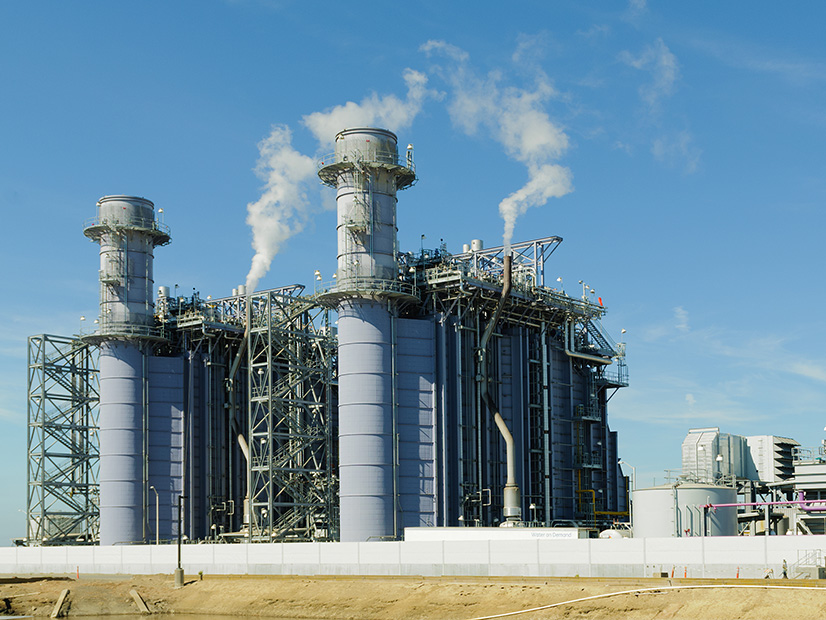The Union of Concerned Scientists released a paper Oct. 15 arguing the electric industry should focus on expanding renewable energy aided with storage rather than keeping natural gas plants running with hydrogen, biomethane or carbon capture and storage (CCS).
“Beyond the Smokestack: Assessing the Impacts of Approaches to Cutting Gas Plant Pollution” noted that gas plants are the largest source of carbon dioxide emissions produced by the electric industry.
“Every path to addressing our nation’s climate commitments and public health priorities calls for a cleaned-up power sector — and that makes reducing CO2 and other harmful emissions from gas plants an urgent priority,” the scientists group said in its paper.
CO2 emissions from power plants are just one way gas plants exacerbate climate change, according to the report, which notes that natural gas itself – methane – is a more potent greenhouse gas, trapping 28 times more heat over 100 years than carbon.
Co-firing hydrogen can cut smokestack emissions, but how the hydrogen is produced has major impacts on the emissions created and can lead to higher emissions than just burning methane, the report said. And because hydrogen is less energy dense than methane, three times as much of it must be burned to produce the same amount of electricity.
“Hydrogen production is energy intensive, making its production method a major factor in determining the overall change in carbon emissions from using hydrogen in gas plants,” the paper said. “Virtually all hydrogen used in the United States today — overwhelmingly for petroleum refining and in the chemicals industry — is produced via steam methane reforming (SMR), the main byproduct of which is CO2.”
That so-called gray hydrogen is not what the industry, or DOE hubs, are trying to promote. They’re pushing so-called blue or green hydrogen, which can be produced via CCS or from water using electrolyzers — though they must be run with zero-carbon power to achieve a carbon-free “green” hydrogen. Even green hydrogen comes with built-in inefficiencies compared to just using renewable electricity directly, according to the report.
“Producing hydrogen by using solar or wind energy to power an electrolyzer with a typical efficiency of 75% and then using that hydrogen in a gas power plant with an efficiency of 45% would result in only one-third as much electricity as that originally supplied by the renewable sources,” the report said. “That is, it would take three times as many wind turbines or solar panels to supply the same amount of electricity via hydrogen blending as from wind or solar directly.”
Hydrogen can be stored but is less efficient than technologies that store electricity outright. It could make sense if other options to capture and store electricity do not work, or in a system that has enough excess renewable electricity to make hydrogen, according to the report, which concluded that direct use of renewable power has a much bigger impact on cutting emissions.
Another option for cleaner gas plants is to keep burning the fuel with a CCS system, an approach the paper claims does not address upstream emissions of methane and introduces other challenges.
“Any CO2 leaking from the pipelines, or the storage would undo the carbon capture effort, at least in part,” the paper said. “Over time, CO2 can slowly leak into the atmosphere if storage reservoirs are not carefully monitored; abandoned oil and gas wells intersecting with CO2 storage sites also increase the risk of leakage.”
CCS technology requires energy to work, and it can take away between 10 to 20% of the electricity produced at the plant, according to the paper, which concluded would exacerbate upstream emissions. The third option cited by the paper is “biomethane” or “renewable natural gas.” It is produced from the anaerobic breakdown of organic matter such as manure, sewage or landfill waste. Smokestack emissions when it is burned are the same, but it avoids emissions in production of the fuel.
The assumption that CO2 produced at the smokestack has a lower climate impact than just venting methane from a farm or dump “is not reasonable in a net-zero framework, where every source of pollution counts; with the United States committed to achieving a net-zero economy by 2050, there is no credibility to a baseline assumption of unmitigated methane venting,” the paper said. “Instead, if biomethane can be captured for use, at minimum, the appropriate baseline climate comparison is flaring, such as is now required at certain regulated landfills.”
It would make more sense, according to the report, to compare biomethane to the best alternative for the climate, which would be to avoid those initial methane emissions through climate-smart farming techniques or avoiding organic waste in landfills.



